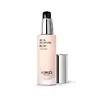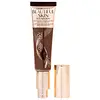What's inside
What's inside
 Key Ingredients
Key Ingredients

 Benefits
Benefits

 Concerns
Concerns

 Ingredients Side-by-side
Ingredients Side-by-side

Pyrus Malus Fruit Water
MaskingWater
Skin ConditioningC12-15 Alkyl Benzoate
AntimicrobialIsododecane
EmollientDimethicone
EmollientHydrogenated Polydecene
EmollientCetyl PEG/PPG-10/1 Dimethicone
EmulsifyingGlycerin
HumectantPropanediol
SolventPhenyl Trimethicone
Skin ConditioningDimethicone Crosspolymer
Emulsion StabilisingTrimethylsiloxysilicate
EmollientPhenoxyethanol
PreservativeSodium Chloride
MaskingMagnesium Sulfate
Sodium Dehydroacetate
PreservativeTriethoxycaprylylsilane
Potassium Sorbate
PreservativeDisteardimonium Hectorite
StabilisingAluminum Hydroxide
EmollientBenzoic Acid
MaskingSodium Hyaluronate
HumectantDehydroacetic Acid
PreservativeLecithin
EmollientPropylene Carbonate
SolventCassia Angustifolia Seed Polysaccharide
Skin ConditioningEthylhexylglycerin
Skin ConditioningHydroxyethylcellulose
Emulsion StabilisingTocopherol
AntioxidantAscorbyl Palmitate
AntioxidantCitric Acid
BufferingCI 77891
Cosmetic ColorantCI 77492
Cosmetic ColorantCI 77491
Cosmetic ColorantCI 77499
Cosmetic ColorantPyrus Malus Fruit Water, Water, C12-15 Alkyl Benzoate, Isododecane, Dimethicone, Hydrogenated Polydecene, Cetyl PEG/PPG-10/1 Dimethicone, Glycerin, Propanediol, Phenyl Trimethicone, Dimethicone Crosspolymer, Trimethylsiloxysilicate, Phenoxyethanol, Sodium Chloride, Magnesium Sulfate, Sodium Dehydroacetate, Triethoxycaprylylsilane, Potassium Sorbate, Disteardimonium Hectorite, Aluminum Hydroxide, Benzoic Acid, Sodium Hyaluronate, Dehydroacetic Acid, Lecithin, Propylene Carbonate, Cassia Angustifolia Seed Polysaccharide, Ethylhexylglycerin, Hydroxyethylcellulose, Tocopherol, Ascorbyl Palmitate, Citric Acid, CI 77891, CI 77492, CI 77491, CI 77499
Water
Skin ConditioningPyrus Malus Fruit Water
MaskingDimethicone
EmollientMica
Cosmetic ColorantOctyldodecyl Stearoyl Stearate
EmollientCetyl PEG/PPG-10/1 Dimethicone
EmulsifyingHydrogenated Ethylhexyl Olivate
EmollientHydrogenated Polyisobutene
EmollientPropanediol
SolventGlycerin
HumectantTrimethylsiloxysilicate
EmollientPolyglyceryl-4 Isostearate
EmulsifyingSodium Chloride
MaskingLauroyl Lysine
Skin ConditioningDimethicone/Vinyl Dimethicone Crosspolymer
Skin ConditioningDisteardimonium Hectorite
StabilisingSodium Dehydroacetate
PreservativeHydrogenated Olive Oil Unsaponifiables
EmollientCaprylyl Glycol
Emollient1,2-Hexanediol
Skin ConditioningTriethoxycaprylylsilane
Sodium Gluconate
Skin ConditioningTocopheryl Acetate
AntioxidantMaltodextrin
AbsorbentBixa Orellana Seed Extract
MaskingPentylene Glycol
Skin ConditioningButylene Glycol
HumectantCassia Angustifolia Seed Polysaccharide
Skin ConditioningSodium Hyaluronate
HumectantCocos Nucifera Fruit Extract
EmollientAluminum Hydroxide
EmollientRosa Damascena Flower Oil
MaskingRosa Damascena Flower Water
MaskingPentaerythrityl Tetra-Di-T-Butyl Hydroxyhydrocinnamate
AntioxidantCI 77891
Cosmetic ColorantIron Oxides
Water, Pyrus Malus Fruit Water, Dimethicone, Mica, Octyldodecyl Stearoyl Stearate, Cetyl PEG/PPG-10/1 Dimethicone, Hydrogenated Ethylhexyl Olivate, Hydrogenated Polyisobutene, Propanediol, Glycerin, Trimethylsiloxysilicate, Polyglyceryl-4 Isostearate, Sodium Chloride, Lauroyl Lysine, Dimethicone/Vinyl Dimethicone Crosspolymer, Disteardimonium Hectorite, Sodium Dehydroacetate, Hydrogenated Olive Oil Unsaponifiables, Caprylyl Glycol, 1,2-Hexanediol, Triethoxycaprylylsilane, Sodium Gluconate, Tocopheryl Acetate, Maltodextrin, Bixa Orellana Seed Extract, Pentylene Glycol, Butylene Glycol, Cassia Angustifolia Seed Polysaccharide, Sodium Hyaluronate, Cocos Nucifera Fruit Extract, Aluminum Hydroxide, Rosa Damascena Flower Oil, Rosa Damascena Flower Water, Pentaerythrityl Tetra-Di-T-Butyl Hydroxyhydrocinnamate, CI 77891, Iron Oxides
Ingredients Explained
These ingredients are found in both products.
Ingredients higher up in an ingredient list are typically present in a larger amount.
Aluminum Hydroxide is a form of aluminum. It can be naturally found in nature as the mineral gibbsite. In cosmetics, Aluminum Hydroxide is used as a colorant, pH adjuster, and absorbent.
As a colorant, Aluminum Hydroxide may add opacity, or reduce the transparency. Aluminum hydroxide is contains both basic and acidic properties.
According to manufacturers, this ingredient is an emollient and humectant. This means it helps hydrate the skin.
In medicine, this ingredient is used to help relieve heartburn and help heal ulcers.
There is currently no credible scientific evidence linking aluminum hydroxide in cosmetics to increased cancer risk.
Major health organizations allow the use of aluminum hydroxide in personal care products and have not flagged it as a carcinogenic risk at typical usage levels.
Learn more about Aluminum HydroxideWe don't have a description for Cassia Angustifolia Seed Polysaccharide yet.
This ingredient is a high molecular weight silicone. It has emulsifying and skin conditioning properties.
Ci 77891 is a white pigment from Titanium dioxide. It is naturally found in minerals such as rutile and ilmenite.
It's main function is to add a white color to cosmetics. It can also be mixed with other colors to create different shades.
Ci 77891 is commonly found in sunscreens due to its ability to block UV rays.
Learn more about CI 77891Dimethicone is a type of synthetic silicone created from natural materials such as quartz.
What it does:
Dimethicone comes in different viscosities:
Depending on the viscosity, dimethicone has different properties.
Ingredients lists don't always show which type is used, so we recommend reaching out to the brand if you have questions about the viscosity.
This ingredient is unlikely to cause irritation because it does not get absorbed into skin. However, people with silicone allergies should be careful about using this ingredient.
Note: Dimethicone may contribute to pilling. This is because it is not oil or water soluble, so pilling may occur when layered with products. When mixed with heavy oils in a formula, the outcome is also quite greasy.
Learn more about DimethiconeDisteardimonium Hectorite comes from the clay mineral named hectorite. It is used to add thickness to a product.
It can also help stabilize a product by helping to disperse other ingredients.
Hectorite is a rare, white clay mineral.
Learn more about Disteardimonium HectoriteGlycerin is already naturally found in your skin. It helps moisturize and protect your skin.
A study from 2016 found glycerin to be more effective as a humectant than AHAs and hyaluronic acid.
As a humectant, it helps the skin stay hydrated by pulling moisture to your skin. The low molecular weight of glycerin allows it to pull moisture into the deeper layers of your skin.
Hydrated skin improves your skin barrier; Your skin barrier helps protect against irritants and bacteria.
Glycerin has also been found to have antimicrobial and antiviral properties. Due to these properties, glycerin is often used in wound and burn treatments.
In cosmetics, glycerin is usually derived from plants such as soybean or palm. However, it can also be sourced from animals, such as tallow or animal fat.
This ingredient is organic, colorless, odorless, and non-toxic.
Glycerin is the name for this ingredient in American English. British English uses Glycerol/Glycerine.
Learn more about GlycerinPropanediol is an all-star ingredient. It softens, hydrates, and smooths the skin.
It’s often used to:
Propanediol is not likely to cause sensitivity and considered safe to use. It is derived from corn or petroleum with a clear color and no scent.
Learn more about PropanediolPyrus Malus Fruit Water is created by distilling parts of the apple.
Apples contain a large amount of antioxidants. Antioxidants help fight free-radicals. Free-radicals are molecules that may damage your skin cells.
The sugar in Apples helps keep the skin hydrated. Apples also contain some acids, such as malic acid. These acids may have a mild exfoliating effect.
Apples also contain Vitamins C and B.
Learn more about Pyrus Malus Fruit WaterChances are, you eat sodium chloride every day. Sodium Chloride is also known as table salt.
This ingredient has many purposes in skincare: thickener, emulsifier, and exfoliator.
You'll most likely find this ingredient in cleansers where it is used to create a gel-like texture. As an emulsifier, it also prevents ingredients from separating.
There is much debate on whether this ingredient is comedogenic. The short answer - comedogenic ratings don't tell the whole story. Learn more about comegodenic ratings here.
The concensus about this ingredient causing acne seems to be divided. Research is needed to understand if this ingredient does cause acne.
Scrubs may use salt as the primary exfoliating ingredient.
Learn more about Sodium ChlorideThis ingredient is a preservative with antimicrobial properties. It is the sodium salt of dehydroacetic acid.
It is especially effective at preventing bacterial and fungal growth in low concentrations.
Sodium Hyaluronate is hyaluronic acid's salt form. It is commonly derived from the sodium salt of hyaluronic acid.
Like hyaluronic acid, it is great at holding water and acts as a humectant. This makes it a great skin hydrating ingredient.
Sodium Hyaluronate is naturally occurring in our bodies and is mostly found in eye fluid and joints.
These are some other common types of Hyaluronic Acid:
Learn more about Sodium HyaluronateTriethoxycaprylylsilane is a silicone used to bind and stabilize ingredients.
As an emulsifier, it helps prevent ingredients from separating. This can help elongate the shelf life of products.
Triethoxycaprylylsilane is often used to coat mineral sunscreens ingredients to help give a better feel. It also helps reduce oxidative stress in sunscreens.
Learn more about TriethoxycaprylylsilaneThis silicone is an emollient. Emollients create a thin film on the skin to prevent moisture from escaping.
It is not soluble in water and helps increase water-resistance in products.
According to a manufacturer, it can blend seamlessly with silicone oils, such as Cyclopentasiloxane.
Learn more about TrimethylsiloxysilicateWater. It's the most common cosmetic ingredient of all. You'll usually see it at the top of ingredient lists, meaning that it makes up the largest part of the product.
So why is it so popular? Water most often acts as a solvent - this means that it helps dissolve other ingredients into the formulation.
You'll also recognize water as that liquid we all need to stay alive. If you see this, drink a glass of water. Stay hydrated!
Learn more about Water